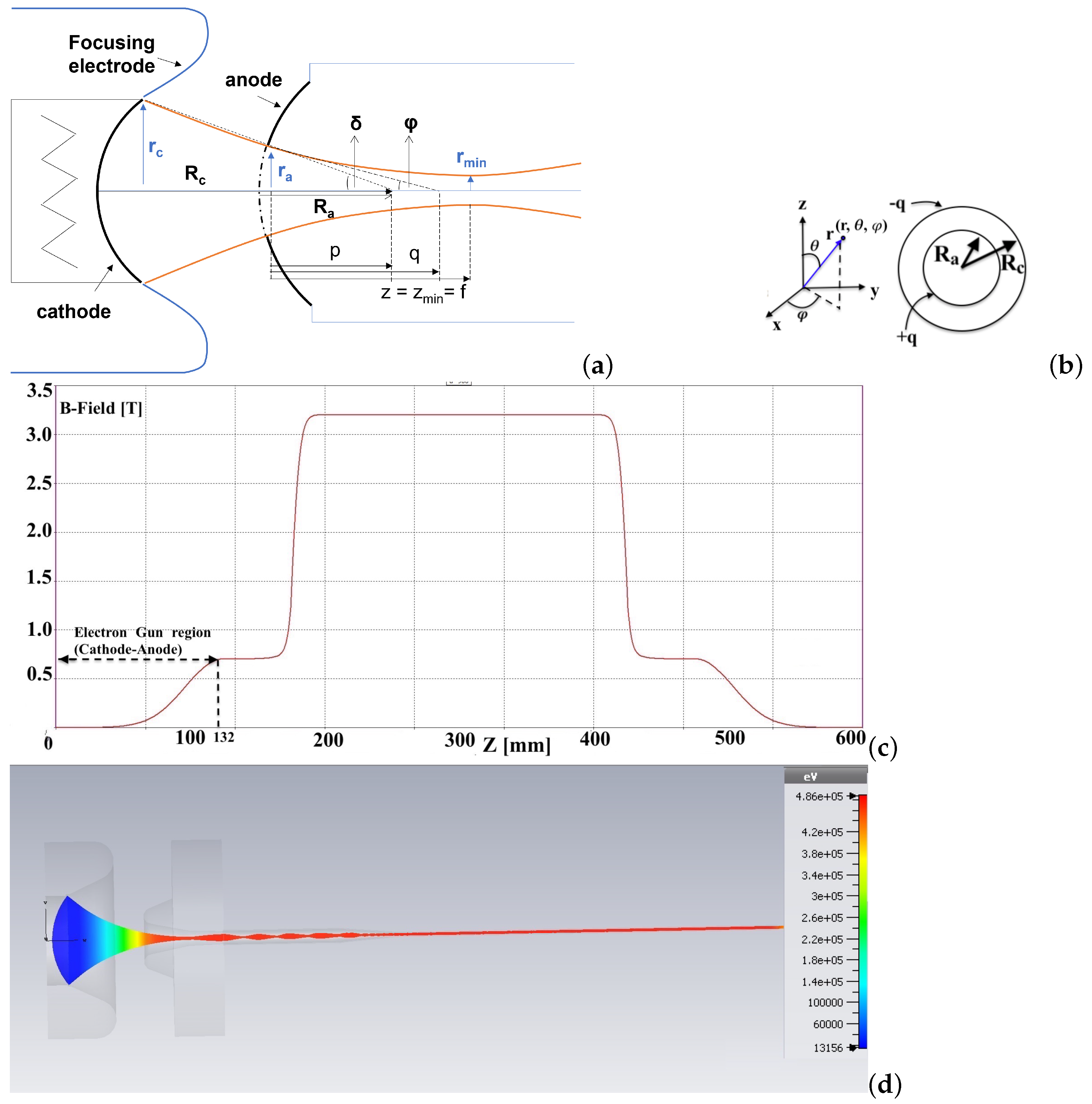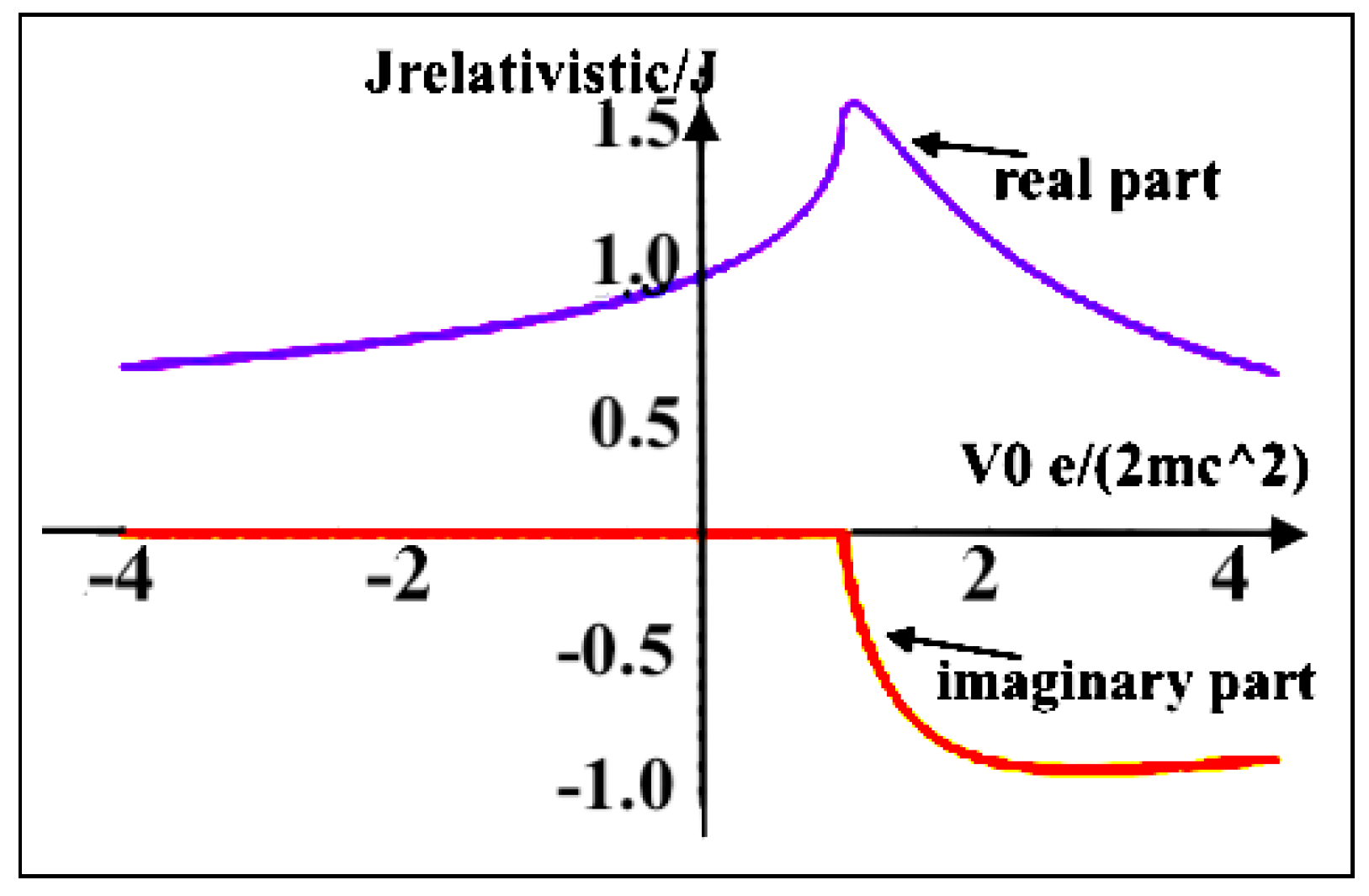Relativistic versus Nonrelativistic Approaches to a Low Perveance High Quality Matched Beam for a High Efficiency Ka-Band Klystron
Abstract
:1. Introduction
2. Design Procedure of the Electron Gun and Focusing Magnetic Field
3. Relativistic Approach to the Design
4. Conclusions
Author Contributions
Funding
Institutional Review Board Statement
Informed Consent Statement
Data Availability Statement
Acknowledgments
Conflicts of Interest
References
- Giribono, A.; Bacci, A.; Chiadroni, E.; Cianchi, A.; Croia, M.; Ferrario, M.; Marocchino, A.; Petrillo, V.; Pompili, R.; Romeo, S.; et al. EuPRAXIA and SPARC-LAB:The high-brightness RF photo-injector layout proposal. In Nuclear Instruments and Methods in Physics Research Section A: Accelerators, Spectrometers, Detectors and Associated Equipment 909; Elsevier: Amsterdam, The Netherlands, 2018; pp. 282–285. [Google Scholar]
- Rosenzweig, J.B.; Majernik, N.; Robles, R.R.; Andonian, G.; Camacho, O.; Fukasawa, A.; Kogar, A.; Lawler, G.; Miao, J.; Musumeci, P.; et al. An ultra-compact X-ray free-electron laser. New J. Phys. 2020, 22, 093067. [Google Scholar] [CrossRef]
- Rosenzweig, J. Ultra-compact X-ray FEL Based on Advanced Cryogenic RF techniques. Bull. Am. Phys. Soc. 2020, 65, 2. [Google Scholar]
- CompactLight Project. Available online: http://www.compactlight.eu/Main/HomePage (accessed on 4 November 2021).
- Shiltsev, V.; Frank, Z. Modern and future colliders. Rev. Mod. Phys. 2021, 93, 015006. [Google Scholar] [CrossRef]
- Behtouei, M.; Faillace, L.; Ferrario, M.; Spataro, B.; Variola, A. A Ka-Band Linearizer TW Accelerating Structure for the Compact Light XLS Project; IOP Publishing: Bristol, UK, 2020; Volume 1596. [Google Scholar]
- Behtouei, M.; Faillace, L.; Spataro, B.; Variola, A.; Migliorati, M. A SW Ka-Band Linearizer Structure with Minimum Surface Electric Field for the Compact Light XLS Project. Nucl. Inst. Methods Phys. Res. A 2020, 984, 164653. [Google Scholar] [CrossRef]
- Behtouei, M.; Spataro, B.; Di Paolo, F.; Leggieri, A. The Ka-Band High Power Klystron Amplifier Design Program of INFN. Vacuum 2021, 191, 110377. [Google Scholar] [CrossRef]
- Lee, T.G.; Konrad, G.T.; Okazaki, Y.; Watanabe, M.; Yonezawa, H. The design and performance of a 150-MW klystron at S band. IEEE Trans. Plasma Sci. 1985, 13, 545–552. [Google Scholar] [CrossRef] [Green Version]
- Yakovlev, V.P.; Nezhevenko, O.A. Limitations on area compression of beams from pierce guns. In AIP Conference Proceedings; American Institute of Physics: College Park, MD, USA, 1999; Volume 474. [Google Scholar]
- Chin, Y.H. Design and performance of L-band and S-band multi beam klystrons. In Proceedings of the LINAC08, Victoria, BC, Canada, 29 September–3 October 2008; Volume 363. [Google Scholar]
- Fazio, M.V.; Habiger, K. Design for a One-Gigawatt Annular-Beam Klystron; No. LA-UR-00-3793; Los Alamos National Lab.: Los Alamos, NM, USA, 2000. [Google Scholar]
- Chang, X.; Jiang, Y.; Shchelkunov, S.V.; Hirshfield, J.L. Ka-Band High Power Harmonic Amplifier for Bunch Phase-Space Linearization. In Proceedings of the North American Particle Accelerator Confefence (NAPAC’19), Lansing, MI, USA, 1–6 September 2019. [Google Scholar]
- Carter, R.G. Microwave and Rf Vacuum Electronic Power Sources; Cambridge University Press: Cambridge, UK, 2018. [Google Scholar]
- Caryotakis, G. High Power Klystrons: Theory and Practice at the Stanford Linear Accelerator Center; Stanford Linear Accelerator Center, SLAC-PUB: Menlo Park, CA, USA, 2004; Volume 139. [Google Scholar]
- CST Studio Suite 2018. Available online: www.cst.com (accessed on 4 November 2021).
- Langmuir, I. The Effect of Space Charge and Residual Gases on Thermionic Currents in High Vacuum. Phys. Rev. 1913, 2, 450. [Google Scholar] [CrossRef]
- Blodgett, K.B. Currents Limited by Space Charge between Concentric Spheres; Thermionic Phenomena: Pergamon, Turkey, 1961; pp. 125–135. [Google Scholar]
- Pierce, J.R. Rectilinear electron flow in beams. J. Appl. Phys. 1940, 11, 548–554. [Google Scholar] [CrossRef]
- Haimson, J. Some aspects of electron beam optics and X-ray production with the linear accelerator. IRE Trans. Nucl. Sci. 1962, 9, 32–49. [Google Scholar] [CrossRef]
- Hinterberger, F. Ion Optics with Electrostatic Lenses. In CAS-CERN Accelerator School and KVI: Specialised CAS Course on Small Accelerators; CERN: Geneva, Switzerland, 2006. [Google Scholar]
- Syratchev, I. Summary of the High-Efficiency (HEIKA) Day; CERN Indico: Geneva, Switzerland, 2016. [Google Scholar]
- Birdsall, C.K. Brillouin Flow Electron Gun. U.S. Patent No. 2817035, 17 December 1957. [Google Scholar]
- Rosenzweig, J.B. Diamagnetic Effects in Beams. 2021; Manuscript in progress. [Google Scholar]
- Rosenzweig, J.B.; Musumeci, P. Diamagnetic Fields due to Finite-Dimension Intense Beams in High-Gain Free-Electron Lasers. Phys. Rev. E 1998, 58, R2737. [Google Scholar] [CrossRef] [Green Version]
- Greenwood, A.D.; Hammond, J.F.; Zhang, P.; Lau, Y.Y. On relativistic space charge limited current in planar, cylindrical, and spherical diodes. Phys. Plasmas 2016, 23, 072101. [Google Scholar] [CrossRef]


| Design Parameters | |
|---|---|
| Beam power [MW] | 48 |
| Beam voltage [kV] | 480 |
| Beam current [A] | 100 |
| Micro-perveance | 0.3 |
| Cathode diameter [mm] | 76 |
| Pulse duration [ sec] | 0.1 |
| Minimum beam radius in magnetic system [mm] | 0.98 |
| Nominal radius [mm] | 1.00 |
| Max EF on focusing electrode [kV/cm] | 200 |
| Electrostatic compression ratio | 1500:1 |
| Beam compression ratio | 1700:1 |
| Emission cathode current density [] | 2.02 |
| Transverse Emittance of the beam [mrad-cm] | 1.23 |
| Parameters | Analytical | Numerical (CST) |
|---|---|---|
| 3.20 | 3.15 | |
| [mm] | 12 | 13 |
| Solid angle, | 16 | 18 |
| Beam angle, | 13 | 14 |
| Beam current [A] | 100 | 100 |
Publisher’s Note: MDPI stays neutral with regard to jurisdictional claims in published maps and institutional affiliations. |
© 2021 by the authors. Licensee MDPI, Basel, Switzerland. This article is an open access article distributed under the terms and conditions of the Creative Commons Attribution (CC BY) license (https://creativecommons.org/licenses/by/4.0/).
Share and Cite
Behtouei, M.; Spataro, B.; Faillace, L.; Carillo, M.; Leggieri, A.; Palumbo, L.; Migliorati, M. Relativistic versus Nonrelativistic Approaches to a Low Perveance High Quality Matched Beam for a High Efficiency Ka-Band Klystron. Instruments 2021, 5, 33. https://doi.org/10.3390/instruments5040033
Behtouei M, Spataro B, Faillace L, Carillo M, Leggieri A, Palumbo L, Migliorati M. Relativistic versus Nonrelativistic Approaches to a Low Perveance High Quality Matched Beam for a High Efficiency Ka-Band Klystron. Instruments. 2021; 5(4):33. https://doi.org/10.3390/instruments5040033
Chicago/Turabian StyleBehtouei, Mostafa, Bruno Spataro, Luigi Faillace, Martina Carillo, Alberto Leggieri, Luigi Palumbo, and Mauro Migliorati. 2021. "Relativistic versus Nonrelativistic Approaches to a Low Perveance High Quality Matched Beam for a High Efficiency Ka-Band Klystron" Instruments 5, no. 4: 33. https://doi.org/10.3390/instruments5040033
APA StyleBehtouei, M., Spataro, B., Faillace, L., Carillo, M., Leggieri, A., Palumbo, L., & Migliorati, M. (2021). Relativistic versus Nonrelativistic Approaches to a Low Perveance High Quality Matched Beam for a High Efficiency Ka-Band Klystron. Instruments, 5(4), 33. https://doi.org/10.3390/instruments5040033









